
views
X
Trustworthy Source
MedlinePlus
Collection of medical information sourced from the US National Library of Medicine
Go to source
Nasal congestion is often (but not always) accompanied by a "runny nose." Nasal congestion has many causes, including viral infections (colds, influenza, sinusitis), allergies (pollen, food, chemicals) and environmental irritants (tobacco smoke, dust, pollution). Learning how to clear nasal congestion quickly is important for getting on with your day instead of being stuck on the couch next to a box of tissues.
Using Natural Methods for Relief
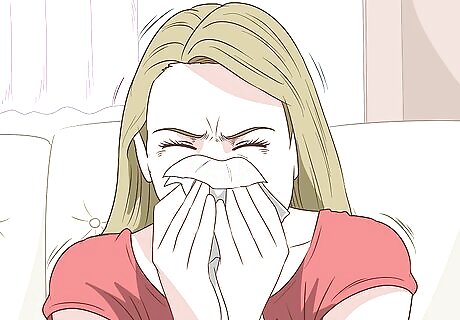
Gently blow your nose. Perhaps the easiest and quickest way to reduce nasal congestion is to simply blow your nose into a soft tissue. Unfortunately, it's not always possible to completely relieve congestion by merely blowing, but it's always a good starting point. Combining periodic nose blowing with some of the techniques listed below is likely the best strategy. When blowing your nose, do it gently, otherwise you risk damaging the delicate nasal/sinus tissues and/or rupturing a small blood vessel. Always use a soft tissue while blowing as it will prevent irritation, redness and chafing from occurring on the end of your nose and around your nostrils. Alternatively, consider blowing your nose into a sink without using tissue. While bending over your bathroom sink, cover one nostril and blow, then switch and do the other side. Wash the sink out when you're finished.
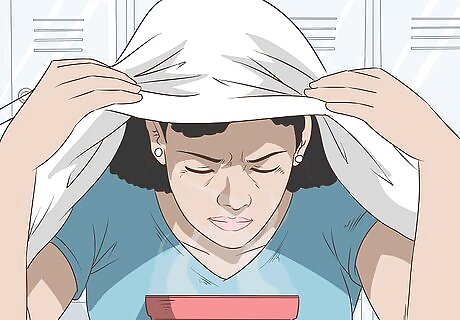
Use steam therapy. Breathing in steam (warm water vapor) can be a very quick and potent decongestant because it loosens up the fluid and mucus within your nasal passages and encourages them to drain out through your nose. Inhale the warm water vapor between two to four times a day, but don't directly inhale hot steam because it can burn your nose and nasal passages and make your condition much worse. Boil an electric kettle on the floor and sit in a chair next to it with a towel draped over your head. Bend over and position yourself so the steam rises up into your face and try to take deep breaths through your nose for between five to 10 minutes. Alternatively, take a long hot shower and breathe in the warm humidity through your stuffed up nose while facing away from the water. After about 10 minutes, try blowing your nose a few times. You can also get some sinus relief by placing a warm, steamy facecloth over your face for a few minutes or until the cloth cools down. Although not as quick, placing a humidifier in your room at night can help decongest your nasal passages because healthy mucus membranes are meant to be moist.
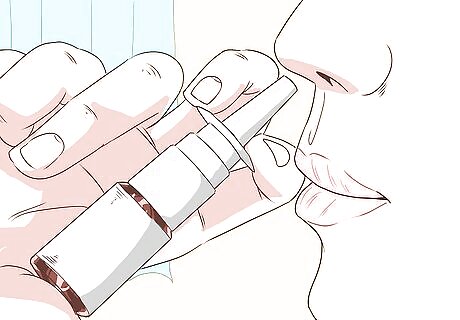
Spray warm saline solution into your nose. Another way of loosening up the fluid and mucus in your sinuses is to spray some warm salt water up into your nose. The warm saline mist can work like a humidifier because it moisturizes the dry tissues within your nasal passages. The salt can also help kill any viruses or bacteria that may be causing the nasal congestion. You can purchase sanitary, pre-made saline solution at the store or make your own. Boil some distilled water and then add some sea salt while it is cooling down (about a teaspoon of salt per 8-ounces of water and maybe a pinch of baking soda too). Add the saline mixture to an empty, clean spray bottle. While holding your head back, spray the saline solution into your nostrils then snort it up into your nasal passages. This may cause you to sneeze. Give two to three sprays per nostril and repeat three to five times daily until the congestion fades away. If you have a sore throat in conjunction with the nasal congestion, then spray the saline solution into the back of your throat.
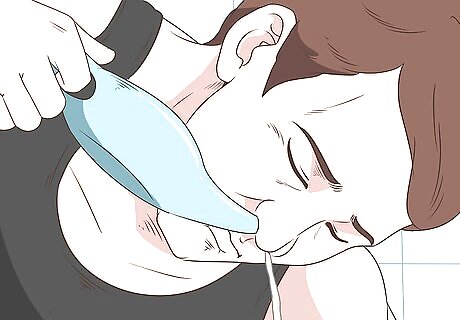
Buy and use a Neti pot for nasal irrigation. Although several methods of nasal irrigation exist, a traditional and effective one is based on the Neti pot — a ceramic or plastic vessel used in Ayurvedic medicine that looks like a cross between a small teapot and Aladdin's magic lamp. You're meant to fill the Neti pot with a saline solution (see above) and pour it up your nose and then let it drain out, which flushes out and sanitizes your nasal passages. Once the Neti pot is filled with warm saline solution, tilt your head sideways over the sink at a 45º angle and place the spout into your top (higher) nostril. Gently pour the solution into that nostril and let it drain out the other side. Spit out any solution that runs into your throat and then blow your nose before doing the other side. Neti pot nasal irrigation can be done three to five times daily, just make sure to thoroughly clean it after every use. The Neti pot has been used for centuries in India and Asia, but its becoming much more popular in the U.S. As such, it can now be found at most drugstores and pharmacies. Always use filtered or distilled water in your Neti pot. If you use tap water, you must boil and/or filter it before use.
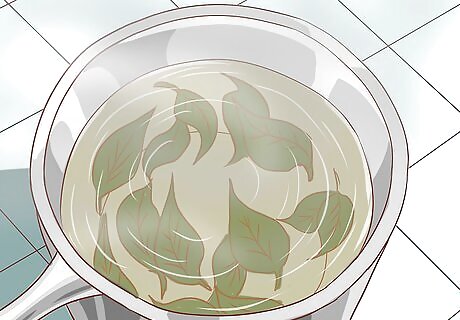
Use herbal oils to decongest. There are a number of herbal oils / extracts / salves that may help decongestion. These herbal products can be added to an overnight humidifier, misting machine, boiling kettle, or even applied directly to the ends of your nose around your nostrils. Common herbs used to help open up your breathing passages include menthol, eucalyptus, camphor and tea tree oil. Olbas oil is a combination of oils meant to help clear your sinuses. Most also have mild numbing and antiseptic properties also. Approximately three to four drops of concentrated menthol, eucalyptus or camphor oil added to a humidifier is usually enough to last a few hours or so. The closer you are to the spout/vapor, the more effective it will be for relieving your congestion. Other plant-based aromatherapy products to consider for sinus congestion are rosemary, peppermint or lemongrass.
Using Quick-Acting Medicine
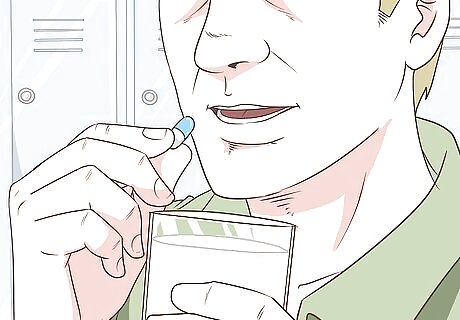
Take an over-the-counter (OTC) decongestant. In general, decongestants, such as Sudafed, Mucinex and Tylenol Sinus, work by shrinking (constricting) blood vessels that cause your nose to be congested and stuffy. These drugs can be found in virtually all pharmacies and drugstores and they tend to work fairly quickly — typically within an hour. Decongestants come in pill form or nasal sprays and are meant for short-term use only (no longer than three to five days). For appropriate dosages, read labels carefully. Ask the pharmacist or your doctor is you're unsure about dosages. Decongestants also tend to dry out the mucus membranes of your nasal passages and sinuses, so make sure to drink lots of water — aim for eight 8-ounce glasses daily. Decongestants can cause some unwanted side effects such as insomnia (trouble getting to sleep), increased blood pressure, headaches and sinus pain.
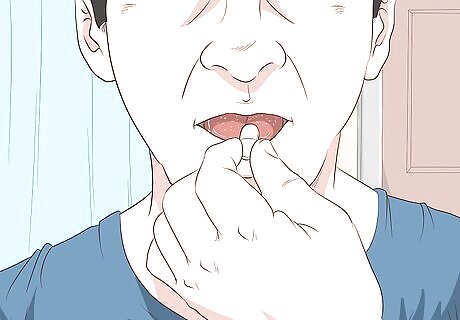
Consider an OTC antihistamine instead. Antihistamines are usually used for nasal congestion caused by allergies — they're also available as pills or nasal sprays for quicker relief. They work by blocking a chemical called histamine, which is over-produced by your body during an allergic reaction. Histamine makes the tissues in your nasal passages swell and get itchy. Many antihistamines cause drowsiness, although some newer formulations tend not to. Do not drive or operate heavy machinery when you take antihistamines that cause drowsiness, such as brompheniramine (Dimetapp Allergy, Nasahist B), chlorpheniramine (Chlor-Trimeton), clemastine (Dayhist, Tavist) or diphenhydramine (Benadryl). If you don't want to get drowsy, then consider using desloratadine (Clarinex), fexofenadine (Allegra) or loratadine (Alavert, Claritin) instead. For best results, antihistamines should be taken before congestion from an allergic reaction gets well established. The sooner the better.

Ask your doctor about corticosteroid sprays. Steroidal nasal sprays can be very effective and fast acting for nasal congestion because they have strong anti-inflammatory properties, but some may need to be prescribed by your doctor (others, such as Flonase, are available over-the-counter). Corticosteroid sprays tend to work well for treating allergic reactions (congestion, runny nose, itching, sneezing) and nasal polyps — noncancerous (benign) growths in the lining of the nasal passage that frequently trigger congestion. Corticosteroid sprays work best when used every day, without interruption, for a preset number of days (such as one to two weeks). Nasal corticosteroid sprays are considered safe for all adults, but not all are recommended for children, so make sure to ask your doctor. Corticosteroids can lead to a variety of side effects, such as: dryness, burning or stinging in the nasal passages, sneezing, nosebleeds, throat irritation, headaches and increased risk of sinus infections.


















Comments
0 comment